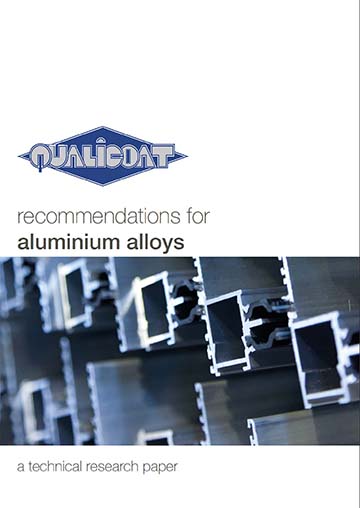The ‘Coatability’ of Aluminium
November 2019
 |
QUALICOAT have undertaken research in the field of recycled aluminium billet quality over the last few years and have produced a document which explains what the acceptable tolerances should be.
‘Recommendations for Aluminium Alloys’, which is available on the QUALICOAT UK & Ireland website, explains in more detail the recommended tolerances.
Architectural powder coating has generally been seen as an impervious coating on aluminium, one that will cover any imperfection present on the aluminium surface. In reality however powder coating is permeable; it is the job of the aluminium pretreatment system to offer the impervious finish to the aluminium whilst offering the ‘key’ for good powder coating adhesion. Furthermore the quality of the aluminium alloy and surface finish prior to pretreatment is crucial to gaining good life expectancy of the completed finish.
As a specifier, the choice of aluminium grades and suitability for the application is important to consider, not only for the structural capability of the installation, but also the life expectancy of the finish which often determines the life of the installation.
Contrary to popular belief powder coating cannot be used to hide poor or corroded aluminium profiles. Very lightly oxidised aluminium, unseen to the naked eye, can be powder coated successfully as the pretreatment process removes the natural oxidisation. It is important to note that as soon as unfinished aluminium is in contact with oxygen then oxidisation begins. The importance of using ‘fresh’ mill material, kept in a temperature controlled store, will help reduce oxidisation, as will aluminium surface protection and the handling of unfinished aluminium with gloves. Where visible oxidisation appears on an extrusion, generally as a white substance, it becomes unsuitable for powder coating. Where this surface oxidisation is present, it is the responsibility of the powder coater to advise their client that their material cannot be coated.
As the level of recycled aluminium content continues to increase there is a need to monitor the quality of the aluminium billet itself, whilst extrudable, the possible increase in contaminants within the aluminium may reduce the performance of the coating.
Aluminium ‘6000’ series extrusion grades EN AW 6060 and EN AW 6063 are commonly used for architectural aluminium systems. These grades allow for various alloys to be present, however, QUALICOAT research suggested that these alloys should be a little tighter specified and if they are, the life expectancy of the coating would be increased.
It is also noted that inappropriate tempering or hardening of the aluminium extrusions to increase its structural strength, normally to the T5 or T6 grades, can cause structures to form in the aluminium surface which are more susceptible to corrosion. QUALICOAT’s research shows that by monitoring the hardness level within prescribed values, by the ‘Best Webster’ or ‘Brinell’ hardness method, life expectancy can again be extended.
It is worth noting that aluminium ‘5000’ series sheet grades also benefit from similar material monitoring and handling when it comes to longevity of powder coat finishing.
QUALICOAT is the only powder coating association that is undertaking pioneering research into not only the ‘coatability’ of aluminium extrusion, but the coatability of aluminium sheet and aluminium castings.
@Qualicoatuki
www.qualicoatuki.org
|
